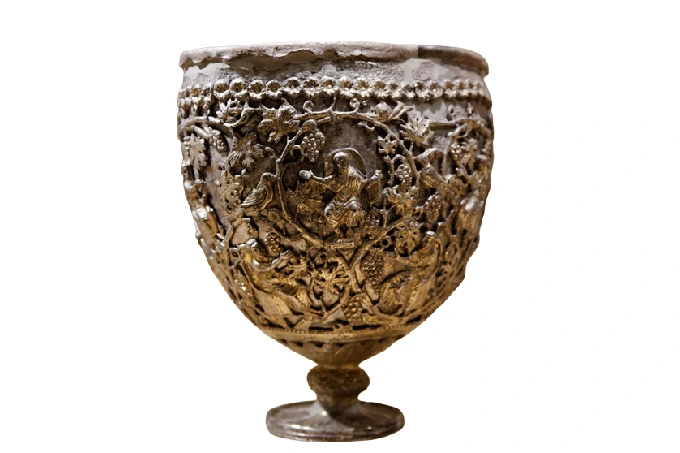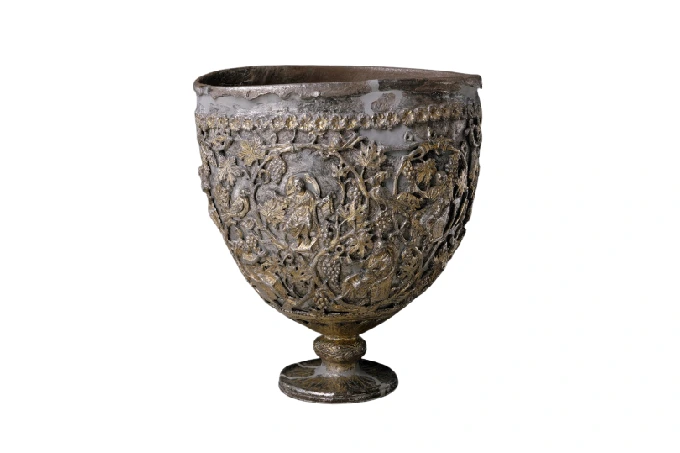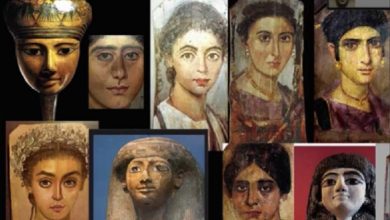The unsolved mystery of the Chalice originating in Antioch

Once upon a time, the discovery of this silver bowl in the excavations of ancient Antioch caused a stir all across the globe. It is a holy relic that has been thought of for two millennia to be one of the greatest hidden riches – the Grail. This is the notion that scientists have put up, and a lot of evidence supports it.
The identical cup that Christ’s followers used to take communion with him at the Last Supper, and also the cup that they used to collect his blood after he was killed. Those who partake of the contents of the Holy Grail cup are said to be granted pardon for their transgressions and everlasting life… What titles have not been bestowed to Antioch at various points in its history? “The City of God,” “Queen of the East,” “Athens of the East,” “the second capital of Christianity,” and many other titles have been bestowed upon this ancient metropolis.
Antioch’s location at the crossroads of the world’s most important trade routes has ensured that the city has always been a magnet for a never-ending stream of merchants, explorers, and other types of travelers. But as the course of events would have it, this city would not develop into a commercial hub until much later in the Middle Ages. Instead, it became one of the most important religious centers on the whole globe.
During the time when Antioch was under Roman control, it was the third biggest city in the Roman Empire (after Rome and Alexandria). There were more than half a million people living there at the time. It was a metropolis with an unfathomable combination of racial groups, peoples, cultures, cults, and religious beliefs; it lived up to the name “Babylon.”
In accordance with the custom that had been established by Seleucus, the founder of the city, anyone who came to reside in the area was automatically granted citizenship rights. These people included Syrians, Greeks, Macedonians, Phoenicians, Jews, Romans, and Persians, amongst many other people groups.
The establishment of a Christian community in Antioch marked the beginning of the global apostolic mission. It was in this city that the word “Christian” was first given to adherents of the Christ-centered faith. This is shown by the holy evangelist Luke, who is considered to be the first historian of the church: “Then Barnabas set out to locate Saul and, after succeeding in his mission, brought Saul back to Antioch. They met at the church every week for a whole year and instructed a sizeable number of disciples. It was during this time that the disciples in Antioch were known as Christians for the first time” (Acts 11:25-26).
Following the fall of Jerusalem in the year 70, Antioch took over as the primary focus of Christian activity and remained so for many decades. Antioch, which had a population of around half a million by the beginning of the fourth century, was the only city in the Roman Empire that could be considered fully Christian due to the rapid growth of the new religion’s adherents here.
Antioch was one of the first locations for the construction of important churches, including the so-called “Ancient” or “Apostolic” Basilica, which is considered to be one of the oldest architectural monuments of early Christianity.
Antioch rose to prominence as the headquarters of the patriarchate throughout the course of time, becoming the hub through which Christians across the vast eastern provinces of the Roman Empire and beyond were connected.
In the year 327, the Roman Emperor Constantine the Great constructed, in the city, one of the greatest and most renowned temples of the early Christian period. He adorned the temple so lavishly that it thrilled the people who lived during his time. This building was known throughout history as the “Great” or “Golden” Church, and it served as an example for a great number of years and centuries.
The Arabs took control of Antioch in August of that year (638). They persecuted local Christians for a significant amount of time because they believed that these Christians were working with their Byzantine foes. Antioch was retaken by the Byzantine empire when it was victorious against the Arabs in the year 969. However, at that point in time, the city had already lost the prominence it formerly held. In the year 1085, the Seljuk Turks were successful in capturing it.
Antakya is the name given to Antioch in modern times. In the southern part of Turkey, there is a little city with a population of just 20,000 people that is nearly brand new. A bridge that was built during the time of the Roman Emperor Diocletian (during the third century AD), an aqueduct, the remnants of Roman temples and theaters, and portions of fortress walls from the sixth century have remained from the once heavily populated capital of the Eastern Empire. It was amid these same ruins, in the middle of the remains of the old city, that in the year 1910, a trove of silverware that included one incredible thing was discovered…
Cup from Antioch
There is still a lack of clarity on the sacred imagery of the events that transpired around the uncovering of the wealth. According to Gustav Eisen’s two-volume study titled “The Great Cup from Antioch,” which was first published in 1923, the wealth was discovered by Arab laborers working in the remains of the Byzantine-era church, also known as the renowned “Golden” Church.
The employees shared the riches that they had discovered among themselves. Later on, the antique company owned by the Kuchakzhi brothers, who had representative offices in Aleppo (Syria), Paris, and New York, purchased the complete collection of Antioch’s treasures and included them into their collection. Salim and Konstantin Kuchakzhi spent two years attempting to collect all of the artifacts that were scattered around the world and held by a variety of individuals. When they had finished this job, they sent the gathered artifacts to their brother George in Paris. George engaged a professional to remove the oxide coating from the silver treasures, and then he gave the items back to them. When the First World War broke out, Kuchaji’s other brother, Habib, and his son Fahim, who was in New York at the time, were responsible for transporting the collection of silver artefacts to a location where they would be totally protected.
One of the things that were included in the treasure from Antioch was a pair of two bowls that were nested inside of each other. The surface of the outer bowl is covered with pictures of people, animals, and vines. The inner bowl has an elongated form, and one of its edges is curved over the edge of the outer bowl. The base of the outer bowl is more expansive. The height of the bowl is more than 19 centimeters, and its circumference is greater than 18 centimeters.
It was pretty obvious that this double dish had a specific function in some context. Fahim Kuchakzhi made a request to the Swedish scientist Gustav Eisen to participate in her study, and she was granted permission to do so. He separated the bowls and inspected each one individually, taking close attention to the adornment that was on each one. Eisen was extremely thorough in his examination of the discovery.

The inner bowl is extremely unlike the outer bowl in that the former is devoid of any embellishments and has a fairly straightforward appearance. The items made around the beginning of the first century BC to the beginning of the first century AD all have a distinctively elongated form.
The bowl on the outside was produced more recently, by a different master, and using a unique crafting method. It portrays twelve different people in various poses. Around them are beautifully entwined vines with hanging bunches; there are also displayed here a variety of things that might be understood as symbols, such creatures sitting on perches. A chain of sockets is formed by the top portion of the inner bowl being twisted outward to produce a protrusion.
Eisen detected two different depictions of Christ among the human figures: in one picture, Christ is shown as a little child, while in the other, Christ is shown after his resurrection. The face of the resurrected Christ is serene and reflective, in contrast to the innocent and charming appearance of Christ when he was a child. Both above and below it are depictions of a dove and an eagle; the former is a representation of the Holy Spirit, while the latter is a representation of the Roman Empire.
Peter, John the Theologian and his brother James, Mark, Andrew, Judas, James the Younger, James the Apostle, Paul, Matthew, and Luke are among the apostles who are seated at various heights around the resurrected Christ. The extraordinary level of expertise possessed by the individuals who were responsible for the creation of this masterpiece gave each of the apostles who were portrayed a distinct personality.
After giving the human beings, animals, and objects shown on the surface of the outer bowl a comprehensive examination, Eisen attempted to interpret them with the help of the gospel texts and all of the other materials that he had access to that dealt with the history of early Christianity. The scientist came to the unmistakable conclusion that the inner cup is a “valuable relic that has passed down to us from the first years of Christianity.”
This relic is known as the renowned Grail Cup. According to Eisen, who was subsequently joined by a number of other scientists, the most hallowed relic connected with the name of Christ is the inner chalice. This is because the inner cup contains the blood of Christ. And if that is the case, then this discovery is very important for all of humankind.
There is no doubt that the spot where people levitated at Easter Antioch is a candidate for the location of the Holy Grail cup. However, many scientists were skeptical of Eisen’s notion, despite the fact that his line of reasoning was very rational. The majority of the concerns, on the other hand, came down to the fact that for a variety of specific reasons, this cup could very easily be made to seem like the Grail cup…
In any case, the cup was the center of everyone’s attention, and the fact that it was connected to the myth of the Holy Grail in some manner considerably raised the value of the discovery. The magnificent treasure of Kuchakzhi was taken on a tour of Europe, where it was shown for everyone to enjoy, and where those who believed in the magical qualities of the object were able to worship it.
The Cloisters Museum of Western Medieval Art in New York City made the acquisition of the bowl in the year 1950. (This museum is a branch of the New York Museum of Art). However, even in this location, It was not able to escape the notice of the general people since incredible things started to take place with the wealth.
1963 was the year that saw the most significant event. The book “100 Great Relics of the World,” which was produced by the Veche publishing firm, provides a description of it. On Easter Sunday, a museum guard and a night watchman were doing their morning rounds when they saw a bowl that was hanging on a shelf suddenly… pause, and then quickly rise to a height that was around 7.5-8 cm higher than before! The dish was suspended in midair for a good number of minutes. After regaining consciousness, the guard hastened to the phone, and after a short while, Thomas Loving, the museum’s assistant curator, hurried inside the premises.
After examining the relic, he proposed the following rationalization for the unexplained occurrence: there was a plastic mesh located between the lamps that were concealed inside the base and the inside of the display case, and it was this mesh that dispersed the rays that were emanating from these light sources.
The security system was designed in such a manner that if a thief attempted to remove the bowl from where it was displayed in the showcase, a certain landmark would be forced into a vertical position, and an alert would be activated at the main office. It just so happened that at that very time, the plastic mesh gave way, causing the bowl to rise and setting off an alarm across the room. The bowl and the net were both propelled upwards into the air as a direct consequence of the landmark being raised.
A random coincidence? Perhaps. On the other hand, the security personnel was unable to be persuaded that the levitation of the bowl might have been caused “by the malfunction” of the alarm system… The provenance of the Antioch Chalice is shrouded in mystery, or at the very least, ambiguity, and this continues to cause concern among specialists.




